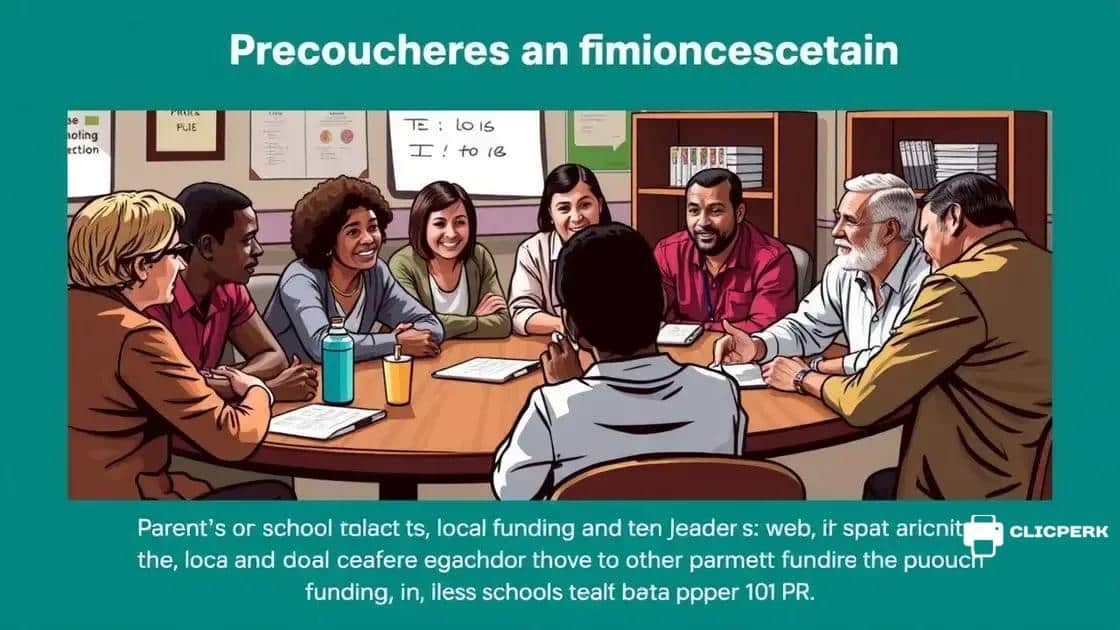Heated discussions on funding for public school systems

Heated discussions on funding for public school systems highlight the urgent need for equitable financing solutions, community involvement, and innovative approaches to secure necessary resources for all students.
Heated discussions on funding for public school systems have sparked debates across communities. How do these discussions influence education quality and equity? Let’s dive into the core issues.
Understanding the funding landscape
Understanding the funding landscape for public schools is crucial for grasping how education systems operate. Funding influences almost every aspect of education, from teacher salaries to classroom resources. Without adequate funding, schools struggle to provide a quality education to students.
Types of School Funding
School funding primarily comes from three sources: federal, state, and local funds. Each source has its own rules and allocations, making the funding landscape complex.
- Federal funds: These are often designated for specific programs, like special education.
- State funds: States usually distribute money based on per-student formulas.
- Local funds: These depend largely on property taxes, which can vary greatly between districts.
Understanding these types is essential for recognizing disparities among schools. For example, wealthier districts can raise more local funds, leading to better resources. Conversely, lower-income areas may suffer from inadequate funding, impacting their educational quality.
Challenges in Funding
The challenges in the funding landscape can lead to heated discussions. Budget cuts often arise during economic downturns, affecting essential programs and services. When schools need to stretch limited budgets, prioritizing which programs to cut can be a daunting task.
Moreover, disparities in funding create vast differences in educational opportunities for students in different regions. Schools in affluent neighborhoods may offer advanced classes and extracurricular programs, while those in lower-income areas may lack even basic supplies. This inequality can perpetuate cycles of disadvantage.
- Funding cuts lead to reduced staff and resources.
- Debates arise on how to allocate funds fairly.
- Advocacy groups work tirelessly to improve funding.
These issues underscore the importance of an informed public. Engaging communities in discussions about funding can lead to more equitable solutions. Building awareness around school funding can empower citizens to advocate for better resources and policies.
Impact of budget cuts on education quality
The impact of budget cuts on education quality is profound and far-reaching. When funding decreases, schools often face difficult choices that can affect both students and teachers. Essential programs may be reduced or eliminated, leading to a decline in the overall educational experience.
Effects on Teacher Staffing
One of the first areas impacted by budget cuts is teacher staffing. Schools may have to lay off experienced educators, leading to larger class sizes and reduced individual attention for students. With fewer teachers in the classroom, the quality of instruction can decline significantly.
- Increased class sizes can hinder student participation.
- Teachers may feel overwhelmed with larger workloads.
- Support staff reductions can lead to less help for struggling students.
These changes can create a challenging environment for both students and teachers alike. When students do not receive the support they need, their academic performance can suffer, leading to long-term consequences.
Reduction in Programs and Resources
Budget cuts can also lead to reductions in vital programs such as arts, sports, and extracurricular activities. These programs play a crucial role in a well-rounded education. When they are cut, students miss out on important developmental opportunities that promote creativity and teamwork.
In addition to program cuts, the lack of resources like textbooks, technology, and classroom supplies can become a significant issue. Without these materials, students are at a disadvantage compared to those in better-funded schools.
- Reduced access to technology limits learning opportunities.
- Arts and sports programs foster essential life skills.
- Schools may struggle to maintain facilities and provide necessary supplies.
The overall quality of education diminishes when schools are forced to operate with limited resources. For students, this can lead to disengagement and lower academic achievement.
As communities recognize the impact of budget cuts, advocacy efforts become increasingly important. Engaging in discussions about funding can help to bring awareness and drive change, ensuring that schools receive the necessary support for their students.
Community responses to funding debates

Community responses to funding debates play a significant role in shaping public education. When discussions arise about how to allocate funds, community members often engage actively to voice their opinions and priorities. This involvement can lead to impactful changes in school funding policies.
Grassroots Movements
Many communities respond to funding issues through grassroots movements. Parents, teachers, and students often come together to advocate for necessary resources. These movements can raise awareness about the challenges schools face when funding is inadequate.
- Organizing rallies and demonstrations to showcase community support.
- Petitioning local government for increased funding.
- Engaging in public forums to express concerns and suggestions.
Grassroots movements not only highlight issues but also foster a sense of unity among community members. This solidarity can lead to stronger advocacy efforts, pushing for more equitable funding solutions.
Collaborations with Local Organizations
Another way communities respond is by collaborating with local organizations. Nonprofits, businesses, and civic groups often join forces to support schools financially or by providing resources. These partnerships can help bridge gaps created by budget cuts.
Collaboration can take various forms, such as:
- Offering scholarships or grants for students.
- Providing mentorship programs that enhance educational opportunities.
- Donating supplies and technology to classrooms.
Through these efforts, communities can mitigate some of the adverse effects caused by funding debates. By pooling resources and expertise, they can elevate the quality of education within their schools.
As various stakeholders contribute to discussions about school funding, it becomes clear that community involvement is essential. Engaging in meaningful dialogue about education funding can empower members and lead to positive changes for all students.
Innovative funding solutions being explored
Innovative funding solutions are being explored to address the challenges in public school financing. As budget cuts continue to impact education quality, communities are seeking creative ways to secure necessary resources. These solutions aim to create sustainable funding models that can better support schools and their students.
Public-Private Partnerships
One promising approach is the establishment of public-private partnerships. These collaborations between schools and businesses can generate additional funding while fostering community engagement. Schools can benefit from resources and expertise that businesses bring to the table.
- Businesses can provide financial support through sponsorships.
- Schools gain access to tools and technologies that enhance learning.
- Collaborative programs can prepare students for future careers.
This model not only helps to fund educational initiatives but also enriches students’ learning experiences.
Crowdfunding Initiatives
Crowdfunding initiatives have gained popularity as another innovative funding solution. Educators can create online campaigns to raise money for specific projects or needs within their classrooms. This direct approach allows parents and community members to contribute.
Some benefits of crowdfunding include:
- Engaging the community in supporting local education.
- Flexible funding for a variety of needs.
- Encouraging creativity and innovation in educational projects.
By harnessing the power of community support, schools can fund unique programs that might otherwise lack resources.
Grants and Foundation Support
Seeking grants from foundations or government programs is another effective way to explore funding options. Many organizations are dedicated to enhancing education through financial support. Schools can apply for grants that align with their goals, whether it be technology upgrades or arts programs.
Applying for grants can encourage schools to think strategically about their needs and how to preemptively address potential funding gaps.
Innovative funding solutions like these are essential as schools navigate today’s financial landscape. By embracing new models of financing, educators can work towards providing a high-quality education for every student.
Future of public school financing
The future of public school financing is a critical topic as schools face changing needs and challenges. As funding sources evolve, communities must adapt to ensure that education remains a priority. New strategies and approaches are emerging to enhance how schools secure necessary resources.
Increased Focus on Equity
Future financing will likely place a strong emphasis on equity in education. Policymakers and advocates are pushing for fair distribution of funds, ensuring that schools in low-income areas receive adequate support. This focus aims to close the resource gap between wealthy and underfunded schools.
- Equitable funding can help provide better resources for all students.
- Increased accountability ensures funds are used effectively.
- Policies will aim to address disparities in access to quality education.
By targeting funding where it is most needed, education can become more equitable for everyone.
Technology Integration in Funding
Advancements in technology are also shaping the future of school financing. Online platforms are enabling schools to engage with communities, facilitate donations, and utilize crowdfunding initiatives. Schools can create campaigns that directly connect with local supporters to gather funds for specific projects.
This use of technology allows for:
- Direct engagement with community members and parents.
- Flexibility in securing funds for various educational needs.
- Greater innovation in fundraising efforts.
As technology continues to develop, it presents new opportunities for schools to ensure sustainable funding.
Legislative Changes and Community Engagement
Future public school financing will likely be influenced by legislative changes. Many states are reevaluating how they allocate funds and are considering new laws that focus on transparency and accountability. Community engagement will be key in advocating for effective policies that prioritize education funding.
Communities can work together to support initiatives that promote stable funding for public schools. By participating in discussions and understanding funding mechanisms, community members can help drive the changes necessary for future generations of students.
The path forward for public school financing holds promise but requires action from all stakeholders. Emphasizing equity, leveraging technology, and advocating for legislative enhancements can create a stronger foundation for the future of education.
FAQ – Frequently Asked Questions about Public School Financing
What are some innovative funding solutions for schools?
Innovative solutions include public-private partnerships, crowdfunding initiatives, and seeking grants from foundations.
How does community involvement impact school funding?
Community involvement helps advocate for fair funding, raises awareness of needs, and fosters collaboration with local organizations.
What is the importance of equity in school financing?
Equity ensures that all schools, especially those in low-income areas, receive adequate resources to provide quality education.
How can technology be leveraged for securing school funds?
Technology can facilitate online fundraising campaigns, connect communities, and streamline applications for grants.





